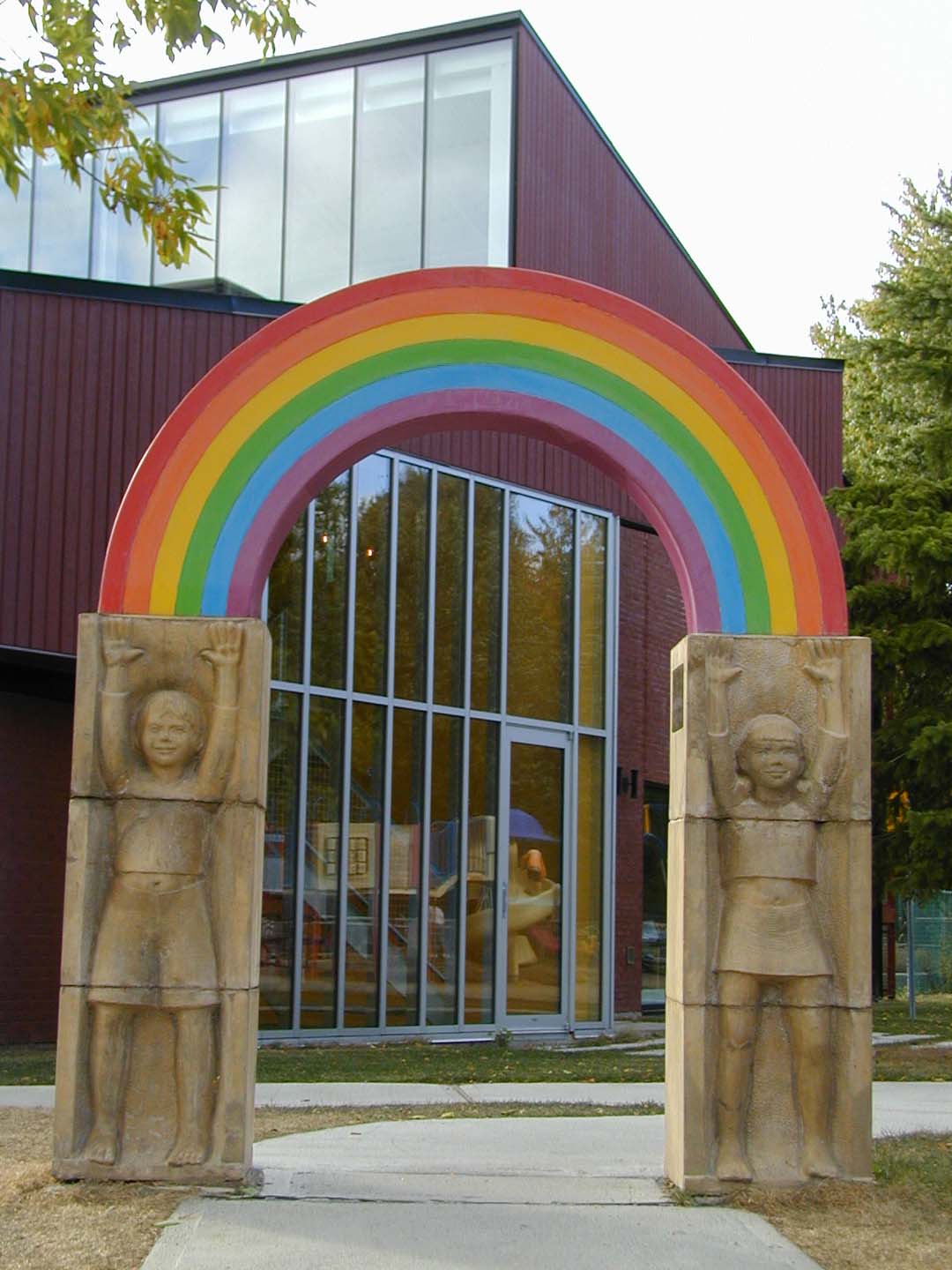Roger Langevin
La porte de l'avenir
2000
Presentation of the artwork
The artwork is situated in front of the Elgar Community Centre on Île-des-Sœurs. It is an arch-shaped sculpture, evoking a rainbow supported by two columns. Each column is formed of three superimposed rectangular blocks in which is sculpted an haut-relief figure, a boy or a girl, arms raised. The same figures are placed on the opposing face of the sculpture so that each column offers an haut-relief likeness of a boy or girl. The rainbow is composed of six bands coloured, respectively, red, orange, yellow, green, blue, and mauve.Langevin’s practice involves figurative sculpture in which the human figure is the focal point: “To the humanist dimension of my work is added a concern with ecology – that is, sculpture as a function of quality of life. I try to find a balance between today’s anguished world and the fact that my figures live in a sort of ideal society.” 1
1. Serge Fisette, “Roger Langevin: glossaire d’un sculpteur,” Espace sculpture, vol. 5, no. 1 (1988): 17.
Associated events
There are three identical copies of this artwork. They are installed in Saint-Lambert, Candiac, and Châteauguay.
Roger Langevin
Roger Langevin studied at the École des beaux-arts de Montréal, then earned a degree in visual arts education at the Université du Québec à Montréal. He was a professor of visual arts from 1963 to 1975. He created a number of monumental sculptures, including, in 1981, Monument aux travailleurs, a permanent artwork for the front of the head office of the Confédération des syndicats nationaux, on Avenue De Lorimier in Montréal. One of his bronze sculptures, Nos traces en héritage (1989), is installed at the Centre de la nature de Laval.
Awards and honours
- Prix des Arts et la Ville pour la sculpture Les pêcheurs (Îles-de-la-Madeleine), 2006
- Récipiendaire de la Distinction Alcide Horth de l’UQAR, 2004
- Reçu au Cercle d’Excellence de l’Université du Québec, 2001
- Deuxième prix au Concours national canadien de Sculpture-emblème, Jeux de la francophonie (Sénégal), 1999
- Finaliste au concours du MEQ pour le Prix de la Ministre, 1988
Presentation of the artwork
The artwork is situated in front of the Elgar Community Centre on Île-des-Sœurs. It is an arch-shaped sculpture, evoking a rainbow supported by two columns. Each column is formed of three superimposed rectangular blocks in which is sculpted an haut-relief figure, a boy or a girl, arms raised. The same figures are placed on the opposing face of the sculpture so that each column offers an haut-relief likeness of a boy or girl. The rainbow is composed of six bands coloured, respectively, red, orange, yellow, green, blue, and mauve.Langevin’s practice involves figurative sculpture in which the human figure is the focal point: “To the humanist dimension of my work is added a concern with ecology – that is, sculpture as a function of quality of life. I try to find a balance between today’s anguished world and the fact that my figures live in a sort of ideal society.” 1
1. Serge Fisette, “Roger Langevin: glossaire d’un sculpteur,” Espace sculpture, vol. 5, no. 1 (1988): 17.
Associated events
There are three identical copies of this artwork. They are installed in Saint-Lambert, Candiac, and Châteauguay.
Roger Langevin
Roger Langevin studied at the École des beaux-arts de Montréal, then earned a degree in visual arts education at the Université du Québec à Montréal. He was a professor of visual arts from 1963 to 1975. He created a number of monumental sculptures, including, in 1981, Monument aux travailleurs, a permanent artwork for the front of the head office of the Confédération des syndicats nationaux, on Avenue De Lorimier in Montréal. One of his bronze sculptures, Nos traces en héritage (1989), is installed at the Centre de la nature de Laval.
Awards and honours
- Prix des Arts et la Ville pour la sculpture Les pêcheurs (Îles-de-la-Madeleine), 2006
- Récipiendaire de la Distinction Alcide Horth de l’UQAR, 2004
- Reçu au Cercle d’Excellence de l’Université du Québec, 2001
- Deuxième prix au Concours national canadien de Sculpture-emblème, Jeux de la francophonie (Sénégal), 1999
- Finaliste au concours du MEQ pour le Prix de la Ministre, 1988





